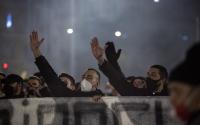Oliver Burkeman in Washington, Stuart Millar, and Nick Paton Walsh in MoscowThursday April 3, 2003
American and British military tacticians rarely tire of invoking the name of Sun Tzu, the ancient Chinese philosopher of war credited with laying the groundwork for everything from "decapitation strikes" to the policy of "shock and awe". But as coalition troops push north for an assault on Baghdad, through stubborn opposition from the most highly trained of Saddam Hussein's fighters, it is another aphorism of Sun Tzu's that may be ringing in the ears of their commanders. "The worst policy," he wrote, brooking no argument, "is to attack cities."
There is nothing encouraging about the list of bloody, high-casualty urban entanglements that strategists on both sides of the Atlantic have been scrutinising for lessons they might apply if drawn into a street-by-street fight for the Iraqi capital. From Stalingrad, Manila and Seoul to Beirut, Grozny and Mogadishu, the history of what the US marines call Mout - military operations on urbanised terrain, known to the British as Fibua, for fighting in built-up areas - is one of massive civilian and military casualties with incendiary effects on public opinion back home.
The Pentagon's gravest nightmare in Baghdad would be what is coming to be known as a "mega-Mogadishu", hundreds of times worse than in 1993, when rebel fighters triumphantly dragged the corpses of American servicemen through the Somali capital, prompting a humiliating US withdrawal. Its own bible on the topic, the 150-page doctrine for joint urban operations, published in September, reminds readers of the bloody, drawn-out battle for the central Vietnamese city of Hue in 1968 which resulted, after four weeks, in the US seizing control of just seven city blocks. And there are troubling reminders of conflicts in Beirut and Lebanon, where battling forces sometimes fought room-by-room for control of individual hotels and apartment blocks.
"Nearly all operations in urban areas _ take significantly longer than expected," the doctrine warns. In training exercises in the swamps of Louisiana, where the marines have built a mock city to practise urban combat, soldiers playing the enemy routinely "kill" or "injure" 60% of the invading force.
"The Iraqis have chosen to try to fight in an urban area because they can - it's the one area where our advantages are somewhat negated," said Colonel Gary Anderson, a retired US marine who fought in Somalia and has trained soldiers for urban combat.
The narrow streets of Baghdad would render useless much of the advanced technology championed by Donald Rumsfeld, while bringing into sharp focus the coalition's political need to avoid major civilian casualties. It would be, as one US colonel put it, like a knife fight in a phone booth.
The biggest advantage the Iraqi forces will have is a relatively intimate knowledge of the "unseen battlefield" inside homes and buildings, on rooftops and beneath the streets. "It's no secret that our intelligence-gathering capabilities are very limited [in Baghdad]," said Colonel Randy Gangle, who, as director of the Centre for Emerging Threats and Opportunities, a marines thinktank, has devised much of the forces' urban training. To attempt to counter this, marines in Baghdad are expected to deploy the Dragon Eye, a hand-launched miniature airplane with a 45in wingspan that can peer around corners.
American strategists freely acknowledge that they are borrowing much of their thinking this time round from the British, with the experience of three decades in Northern Ireland and 10 years of peacekeeping from the Balkans to Africa.
The British model views the city not as a single military objective, but as a series of bite-sized chunks, perhaps as small as a single building or a street. After the first chunk is taken, forces move in to consolidate their control, setting up strongholds used as launchpads for the attack on the next chunk. At the same time, it is essential to build relationships with the local population in the chunks already taken.
"It's very much like viewing the city as a chessboard," said Garth Whitty, a retired lieutenant-colonel and now a defence analyst at the Royal United Services Institute in London. "You move into one square, you hold it and you use it as a base to move on to the next square. You have to be patient."
Col Gangle said gathering intelligence to counter the Iraqi regime's tactic of basing military command points among civilians was already happening in Iraq. "The key is starting to develop intelligence from the population - patrols can go in, and clan destinely talk with people and say, 'We don't want you to expose yourselves, but we do want you to tell us who the bad guys are, and we'll go deal with them.' As people begin to realise that they can provide information without repercussion, the effect will grow exponentially. It's not this room-by-room, building-clearing thing that we used to do."
The benefits of firepower are limited: blasting buildings with artillery or air strikes may take out any enemy positions, but it also creates debris which has to be negotiated and which offers cover for enemy forces. This means urban warfare is infantry-intensive. "It's rifles and bayonets stuff," one senior British trainer said. Troops "get tired fighting at this sort of intensity. It's not just physically exhausting, it's mentally exhausting."
In Iraq, there will be one major difference from previous urban warfare situations: the stated objective of minimising civilian casualties. "You have immediately changed the rules to your disadvantage because you have to be more selective about targets but also you subject your people to greater danger," Mr Whitty said.
The controversial alteration to US rules of engagement seen outside the cities of Iraq - where troops are cleared to fire on approaching civilians if they cannot make them halt and fear a suicide attack - would be much more fraught inside Baghdad. "It's one thing to have a defensive position and say, 'You may not come any closer,'" said Col Gangle, "but it's a different scenario when you're patrolling a city and people are coming into close contact all the time."
In this chaos, it will be virtually impossible for commanders to keep track of everything happening on the ground, so the British approach is to devolve command to the lowest possible level. Tactical decisions on the ground will be taken by the patrol commanders, usually corporals or lance corporals. "The principle is intent," Col Gangle said. "You expect, even if you lose contact, your subordinates to continue to operate within your intent."
But some British military experts argue that the Americans may be less prepared for this kind of structure, since their training focuses on implementing a gameplan decided by senior officers.
"The British troops will have got their heads around what is expected of them before they hit the ground," said John MacKinlay, a former senior British officer and now a research fellow at Kings College's centre for war studies. "The American GI, by contrast, will have been brought up in a total war machine."
The disastrous consequences of getting it wrong were illustrated in the Russian military's attempts to take the city of Grozny in 1994 and 2000.
General Alexander Vladimirov, vice-president of the Association of Military Experts and an infantry specialist, said Russian experiences during Grozny's first assault in December 1994 showed how vital it was to properly reconnoitre the city before an assault, using scale models based on satellite photographs. "Our reconnaissance was absolutely ineffective in Grozny in 1994," he said. "We did not work out where the enemy had placed the snipers, machine guns and RPGs. I think the same thing will apply to Baghdad." The failed first operation against Grozny led to its carpet bombing in January 1995.
For the second siege, five years later, a humanitarian corridor was left open so the population could flee. "We warned them to get out," said Gen Vladimirov, and "honestly told them we would flatten the city. We waited for a long time."
And yet despite extensive planning by the Russian army, based on their past mistakes, Russian assault groups were still cut to pieces as they entered Grozny in 2000 by rebels targeting their tank columns, picking off vehicles one by one.






